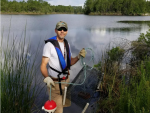
When it comes to investing in the future of the great outdoors of Northwest Florida, Gulf Power’s Environmental Stewardship Coordinator Jeff Cole is always willing to step up. Even if it means babysitting.
Cole is among 179 citizens who have signed up to be sitters of 4,005 baby scallops for a Florida Fish and Wildlife Conservation Commission programaimed at engaging citizens in conservation efforts.
“I remember when scallops were plentiful in the area, and it sounded like a good program to get scallop numbers back up,” said Cole, a Santa Rosa County native who works in Gulf Power’s Panama City office. “We use these bays to recreate and to fish, so it should be our responsibility to help keep them healthy and teeming with marine life for generations to come.”
The scallop-sitting program is part of an ambitious 10-year restoration project FWC launched in 2016 to restore the once-thriving scallop population all along the Florida Panhandle — from Pensacola to Apalachicola — that once supported a commercial fishing industry until the 1950s.
This year, FWC began enlisting the public in the Panama City area to focus efforts on seeding St. Joseph Bay and St. Andrew Bay with the tasty mollusks. The program kicked off in April with an educational workshop and runs through January 2019.
Biologist Austin Heil said the citizens’ program is about increasing scallop production and raising public awareness. “We put 4,000 scallops in St. Joseph Bay last year. This year, the citizens’ program has helped us double our efforts,” he said. “The idea is to get people to care.”
Sitters were provided wild and hatchery-raised baby scallops and cages to protect the tiny mollusks from predators to improve their survival rate as they grow. Volunteers also received a T-shirt emblazoned with a baby scallop in a crib. Sitters deployed the cages in the water off of their private docks or used boats to drop them into the bays and check on them and report their progress on regular basis.
Cole dropped one cage of 29 scallops into North Bay and deployed another cage of 27 scallops into St. Andrew Bay near the Cove Park area. Both sets of scallops were doing well until heavy rains hit in late May and early June, flooding North Bay with fresh water.
“The North Bay scallops died when the salinity of the bay dropped too much from all of the rain,” Cole said. “But this year’s failures and successes will provide important information for FWC to know where to focus scallop seeding next year.”
Cole’s St. Andrew Bay scallops are thriving and growing and will be released from the cage after they reach adult breeding size in the fall. “The hope is they’ll spawn in the cages to improve chances of reproduction because outside of the cages the scallops would spread out far and wide in the bay, and the eggs might not get fertilized,” he said.
Bay scallops live in the shallow grasses of nearshore waters along Florida’s Gulf Coast, from Pensacola to the Florida Keys, and are easily recognizable from other seagrass critters by their 200 electric blue eyesscanning their surroundings and their ability to jet away by snapping their bi-valve shells.
Since populations have been declining, scallop harvesting is illegal west of the Gulf and Bay counties and harvesting is only allowed in certain bays during scallop harvesting season, which runs from Aug. 17-Sept. 30 in St. Joseph Bay and Gulf County.
FWC only offers the scallop-sitting program in the Panama City area and St. Joseph Bay for now. Heil said it has enough volunteers for this year but is compiling a list of volunteers for next season. Interest is so high, he already has 50 people on a waiting list.
Rick O’Connor, Sea Grant Extension agent for Escambia County, said he is looking forward to FWC offering the citizens’ program in Santa Rosa Sound and Big Lagoon — prime spots for scallops — in the future but, currently, there are too few scallops for the program to be successful.
“We generally find scallop shells but few live ones around here,” he said. Sometimes, piles of scallop shells are found near public water access points, indicating scallops are being illegally harvested, which impacts the chances for the species recovery, he pointed out.
To get a better handle on the population, O’Connor said Sea Grant is recruiting volunteers to help with a scallop-survey program this summer in Santa Rosa and Escambia counties as an important step in restoring populations.
- Interested in participating in the survey? Contact Chris Verlinde for Santa Rosa County at 623-3868 or chrismv@ufl.edu; or Rick O’Connor, for Big Lagoon at 475-5230 or roc1@ufl.edu.
- Interested in becoming a scallop-sitter for the 2019 season in the Panama City area, emailbayscallops@myfwc.com.
####
About Gulf Power
Gulf Power serves more than 460,000 customers in eight counties throughout Northwest Florida. The company’s mission is to safely provide exceptional customer value by delivering reliable, affordable and environmentally responsible electricity while strengthening our communities. Visit online at MyGulfPower.com or on the company’s Facebook, Instagram and Twitter pages. News information can be found at GulfPowerNews.com
News Media Contacts:
Rick DelaHaya
Media Relations
850.872.3205, cell 318-294-2338
Kimberly Blair
Media Relations
850-444-6050, cell 850-206-5132
GordonPaulus
Media Relations
850.444-6320, cell 850-525-7510